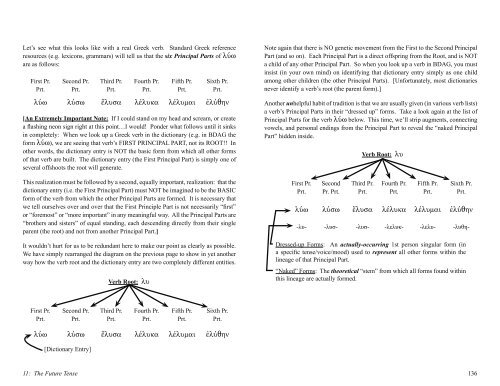Elementary New Testament Greek, 2014a
Elementary New Testament Greek, 2014a
Elementary New Testament Greek, 2014a
You also want an ePaper? Increase the reach of your titles
YUMPU automatically turns print PDFs into web optimized ePapers that Google loves.
Let’s see what this looks like with a real <strong>Greek</strong> verb. Standard <strong>Greek</strong> reference<br />
resources (e.g. lexicons, grammars) will tell us that the six Principal Parts of <br />
are as follows:<br />
First Pr.<br />
Prt.<br />
Second Pr.<br />
Prt.<br />
Third Pr.<br />
Prt.<br />
Fourth Pr.<br />
Prt.<br />
Fifth Pr.<br />
Prt.<br />
Sixth Pr.<br />
Prt.<br />
μ <br />
[An Extremely Important Note: If I could stand on my head and scream, or create<br />
a ashing neon sign right at this point…I would! Ponder what follows until it sinks<br />
in completely: When we look up a <strong>Greek</strong> verb in the dictionary (e.g. in BDAG the<br />
form ), we are seeing that verb’s FIRST PRINCIPAL PART, not its ROOT!! In<br />
other words, the dictionary entry is NOT the basic form from which all other forms<br />
of that verb are built. The dictionary entry (the First Principal Part) is simply one of<br />
several offshoots the root will generate.<br />
This realization must be followed by a second, equally important, realization: that the<br />
dictionary entry (i.e. the First Principal Part) must NOT be imagined to be the BASIC<br />
form of the verb from which the other Principal Parts are formed. It is necessary that<br />
we tell ourselves over and over that the First Principle Part is not necessarily “rst”<br />
or “foremost” or “more important” in any meaningful way. All the Principal Parts are<br />
“brothers and sisters” of equal standing, each descending directly from their single<br />
parent (the root) and not from another Principal Part.]<br />
It wouldn’t hurt for us to be redundant here to make our point as clearly as possible.<br />
We have simply rearranged the diagram on the previous page to show in yet another<br />
way how the verb root and the dictionary entry are two completely different entities.<br />
Verb Root: <br />
Note again that there is NO genetic movement from the First to the Second Principal<br />
Part (and so on). Each Principal Part is a direct offspring from the Root, and is NOT<br />
a child of any other Principal Part. So when you look up a verb in BDAG, you must<br />
insist (in your own mind) on identifying that dictionary entry simply as one child<br />
among other children (the other Principal Parts). [Unfortunately, most dictionaries<br />
never identify a verb’s root (the parent form).]<br />
Another unhelpful habit of tradition is that we are usually given (in various verb lists)<br />
a verb’s Principal Parts in their “dressed up” forms. Take a look again at the list of<br />
Principal Parts for the verb below. This time, we’ll strip augments, connecting<br />
vowels, and personal endings from the Principal Part to reveal the “naked Principal<br />
Part” hidden inside.<br />
First Pr.<br />
Prt.<br />
Second<br />
Pr. Prt.<br />
Verb Root: <br />
Third Pr.<br />
Prt.<br />
Fourth Pr.<br />
Prt.<br />
Fifth Pr.<br />
Prt.<br />
Sixth Pr.<br />
Prt.<br />
μ <br />
-- -- -- -- -- --<br />
Dressed-up Forms: An actually-occurring 1st person singular form (in<br />
a specic tense/voice/mood) used to represent all other forms within the<br />
lineage of that Principal Part.<br />
“Naked” Forms: The theoretical “stem” from which all forms found within<br />
this lineage are actually formed.<br />
First Pr.<br />
Prt.<br />
Second Pr.<br />
Prt.<br />
Third Pr.<br />
Prt.<br />
Fourth Pr.<br />
Prt.<br />
Fifth Pr.<br />
Prt.<br />
Sixth Pr.<br />
Prt.<br />
μ <br />
[Dictionary Entry]<br />
11: The Future Tense<br />
136


















